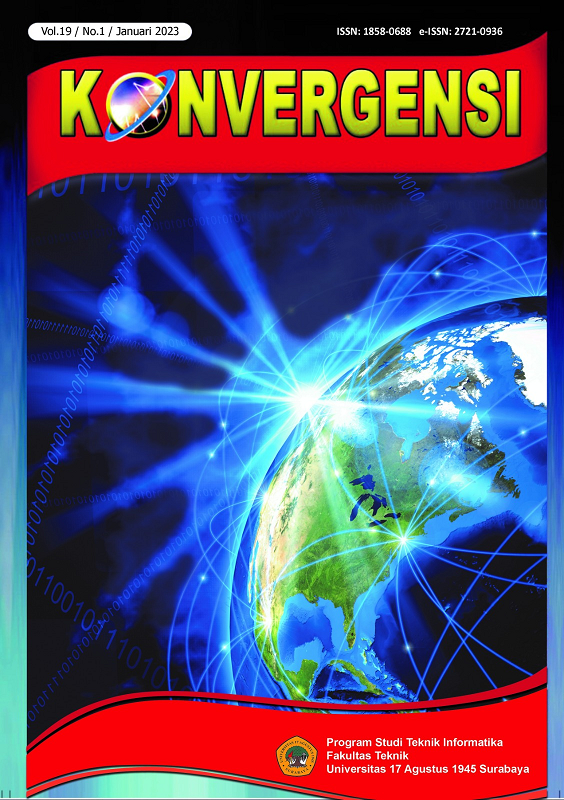Rancang Bangun Termometer Real Time Berbasis Internet of Things
DOI:
https://doi.org/10.30996/konv.v19i1.6414Keywords:
Hipertermi, Hipotermi, IoT, TermometerAbstract
The most frequent and easiest way to check vital signs is to check body temperature. Body temperature in adulthood is lower than that of children because the immune system in the body in adulthood is good, but it does not rule out an increase in body temperature as a sign of quality decline because adulthood is an age that is very easy and vulnerable to contracting a disease. Therefore, it is necessary to check body temperature regularly to determine the condition of the body. Checking body temperature can be done more easily using a real time thermometer based on the Internet of Things. The Internet of Things-based real time thermometer is a development of conventional thermometers, the difference lies in monitoring which can be in real time without being limited by distance as long as it is connected to the internet. This thermometer monitors the patient's temperature in real time and will give a warning if there is a decrease or increase in temperature that can cause the patient's body to experience hypothermia or hyperthermia, besides that this tool can display the patient's temperature directly through the LCD on the device or directly viewed through a cellphone. The method used in this research is descriptive exploratory, in this research development is carried out and is one type of research that can be a liaison or breaker of the gap between basic research and applied research. The temperature that can be read on a real time thermometer based on the Internet of Things starts from 20℃ - 50℃ with an accuracy of 0,5℃.
Keywords: Hyperthermia, Hypothermia, IoT, Thermometer
ABSTRAK
Pemeriksaan tanda vital yang paling sering dan mudah dilakukan yaitu pemeriksaan suhu tubuh. Suhu tubuh pada usia dewasa lebih rendah dari usia anak-anak karena sistem imun dalam tubuh pada usia dewasa sudah baik, akan tetapi tidak menutup kemungkinan terjadi peningkatan suhu tubuh sebagai tanda penurunan kualitas kesehatan karena usia dewasa merupakan usia yang sangat mudah dan rentan untuk terjangkit suatu penyakit. Oleh karena itu diperlukan adanya pemeriksaan suhu tubuh secara rutin untuk mengetahui kondisi tubuh. Pemeriksaan suhu tubuh dapat dilakukan dengan lebih mudah menggunakan termometer real time berbasis Internet of Things. Termometer real time berbasis Internet of Things merupakan pengembangan dari Termometer konvensional, perbedaannya terletak pada pemantauan yang bisa secara real time tanpa dibatasi jarak asalkan terhubung dengan internet. Termometer ini memantau suhu pasien secara real time dan akan memberikan peringatan jika terjadi penurunan maupun peningkatan suhu yang dapat menyebabkan tubuh pasien mengalami hipotermi maupun hipertermi, selain itu alat ini dapat menampilkan suhu pasien langsung memlalui LCD pada alat maupun langsung dilihat melalui handphone. Metode yang digunakan pada penelitian ini adalah deskriptif eksploratif, dalam penelitian ini dilakukan pengembangan dan merupakan salah satu jenis penelitian yang dapat menjadi penghubung atau pemutus kesenjangan antara penelitian dasar dengan penelitian terapan. Suhu yang dapat dibaca pada termometer real time berbasis Intenet of Things mulai dari 20℃ - 50℃ dengan akurasi 0,5℃.
Kata Kunci: Hipertermi, Hipotermi, IoT, Termometer
Downloads
Downloads
Published
Issue
Section
License
Authors whose manuscript is published will approve the following provisions:
- The right to publication of all journal material published on the Konvergensi Teknologi Informasi & Komunikasi website is held by the editorial board with the author's knowledge (moral rights remain the property of the author).
- The formal legal provisions for access to digital articles of this electronic journal are subject to the terms of the Creative Commons Attribution-ShareAlike (CC BY-SA) license, which means Konvergensi Teknologi Informasi & Komunikasi reserves the right to store, modify the format, administer in database, maintain and publish articles without requesting permission from the Author as long as it keeps the Author's name as the owner of Copyright.
- Printed and electronic published manuscripts are open access for educational, research and library purposes. In addition to these objectives, the editorial board shall not be liable for violations of copyright law.







